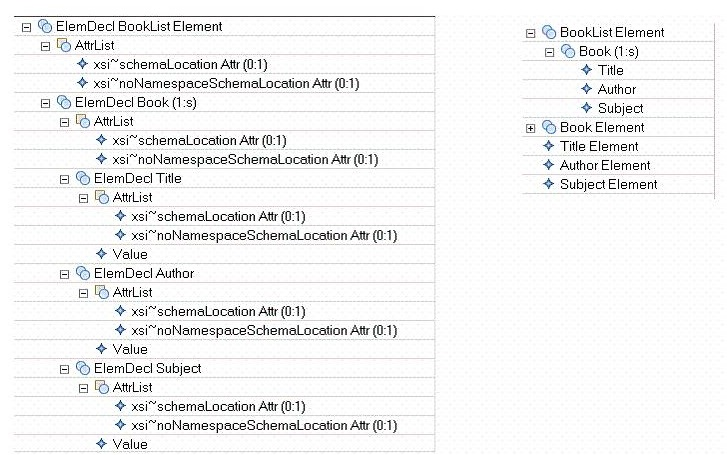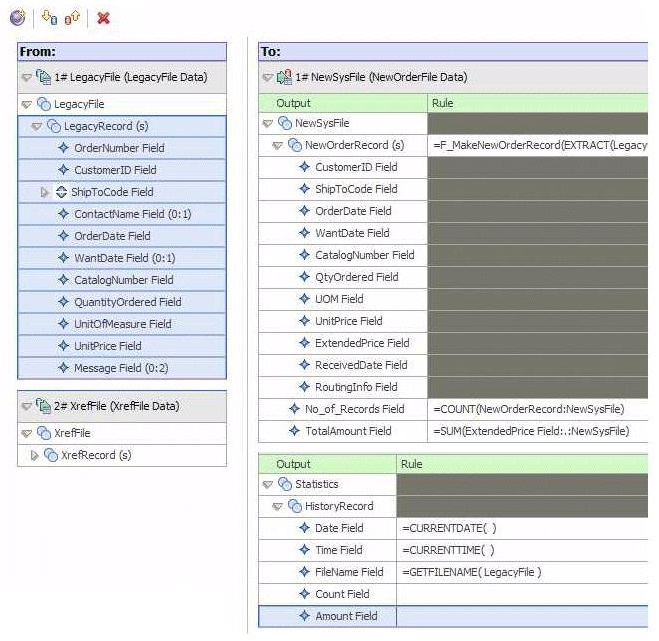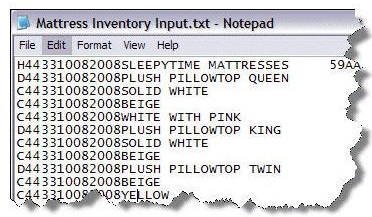IBM WebSphere Transformation Extender V8.4, Application Development v6.0
Question 1
Refer to image shown here:

Which of the following statements is TRUE with regards to the type trees created using the
XML Schema Importer.
- A. The trees were created with different schemas.
- B. One tree was created using XSDL Hints and Xerces validation.
- C. One tree was created using Classic validation and XSDL Hints.
- D. One tree was created using Classic validation and the other using Xerces validation.D.One tree was created using Classic validation and the other using Xerces validation.
Answer : B
Question 2
An application developer is creating a map to produce a report which will include literal text concatenated with a numeric item named TotalCount. Which map rule should the developer use to produce the following line of their report if TotalCount = 2541? The totals are 2,541!
- A. ="The totals are " + NUMBERTOTEXT (TotalCount) + "!"
- B. ="The totals are " + FROMNUMBER (TotalCount, "{#','###}") + "!"
- C. ="The totals are " + NUMBERTOTEXT (TotalCount, "{#','###}") + "!"
- D. ="The totals are " + CONVERTTOTEXT (TotalCount, "{#','###}") + "!"
Answer : B
Question 3
An application developer wants to read a 2GB file that contains two million records of 1KB each, and ensure that no data is processed unless all the input data is valid. What are the
BEST card settings?
- A. FetchAs= Burst, Scope=Map, OnSuccess=Delete, OnFailure=Rollback
- B. FetchAs= Burst, Scope=Burst, OnSuccess=Delete, OnFailure=Rollback
- C. FetchAs= Integral, Scope=Map, OnSuccess=Delete, OnFailure=Rollback
- D. FetchAs= Integral, Scope=Card, OnSuccess=Delete, OnFailure=Rollback
Answer : A
Question 4
What is the difference between a map called using the RUN function and a functional map?
- A. A map called using the RUN function is a compiled map, a functional map is not.
- B. A map called using the RUN function is referenced by another map through a map rule, a functional map is not
- C. The data sources and target settings are not ignored in a map called using the RUN function, they are ignored in a functional map.
- D. The definition for a map called using the RUN function does not need to be in the same map source file as the executable map, the functional map definition does.
Answer : C
Question 5
In addition to the adapters, what WebSphere Transformation Extender component would be needed in a production environment?
- A. Design Studio
- B. Transformation Engine
- C. Integration Flow Designer
- D. Database Interface Designer
Answer : B
Question 6
A application developer is trying to build a map rule, but cannot get the syntax right. What is the next troubleshooting step?
- A. Comment out parts of the rule until it's valid.
- B. Try another function, which may work just as well.
- C. Change the map build settings to ignore syntax errors.
- D. Hard code the expected output value into the rule as a workaround.
- E. Run the map rule through the syntax checker wizard in Design Studio.
Answer : A
Question 7
Refer to the image shown here:

Output card #2 creates a summary report that provides run time statistics. The Amount field in output card #2 is the total amount of all orders in the NewSysFile. Output card #2 creates a summary report that provides run time statistics. The Amount field in output card #2 is the total amount of all orders in the NewSysFile. Output card #2 creates a summary report that provides run time statistics. The Amount field in output card #2 is the total amount of all orders in the NewSysFile. Which of the following is the MOST EFFECIENT map rule for the
Amount field in output card #2?
- A. =TotalAmount Field:NewSysFileA.=TotalAmount Field:NewSysFile
- B. =SUM(TotalAmount Field:NewSysFile)B.=SUM(TotalAmount Field:NewSysFile)
- C. =ADD(ExtendedPrice Field:.:NewSysFile)C.=ADD(ExtendedPrice Field:.:NewSysFile)
- D. =ExtendedPriceField:.:NewSysFile * No_of_Records Field:NewSysFileD.=ExtendedPriceField:.:NewSysFile * No_of_Records Field:NewSysFile
Answer : A
Question 8
What is the primary difference between a choice group and a partitioned group?
- A. A choice group requires that data must be distinguishable; a partitioned group does not.
- B. A partitioned group requires that data must be distinguishable; a choice group does not.
- C. A choice group can have both items and groups as components; a partition group can only have groups as subtypes.
- D. A partitioned group can contain both items and groups as components; a choice group can only contain groups as components.
Answer : C
Question 9
What is the BEST method to create a backup of bad input data?
- A. Use a REJECT function.
- B. Map errors to an output card.
- C. Enable backup OnError in the map settings.
- D. Enable backup OnError on each card needed.
Answer : D
Question 10
Refer to the image shown here:

A large corporation manufactures beds in different colors. The inventory file consists of three record types, a header, a detail, and bed color. The record type is the first byte of each record (H=Header, D=Detail, C=Color). If there is an error in one of the bed color records, all of the color records under that detail record should be ignored. How can an application developer specify that all color records should be ignored if one is found to be invalid?
- A. Use the restart function in the map.
- B. Use the restart attribute on the color record.
- C. Use the restart attribute on the detail record.
- D. Use the restart attribute on the header record.
Answer : C
Question 11
Which product is used to develop and test WebSphere Transformation Extender maps and type trees?
- A. Design Studio
- B. Business Modeler
- C. Integration Developer
- D. Integration Flow Designer
Answer : A
Question 12
Which setting has the MOST negative impact on map performance?
- A. Backup
- B. Audit Log
- C. Map Retry
- D. Map Trace
Answer : D
Question 13
The following map rule returns the incorrect results; however, the map rule does return the expected results when each LOOKUP is run independently.
=IF(PRESENT(Name:.:AddressFile), LOOKUP(Record:input,Field1
Field:Record:input="aa"), LOOKUP(Record:input,Field1 Field:Record:input="cc"))
Why does the rule return the INCORRECT results?
- A. Both LOOKUPs reference the same series object.
- B. Two LOOKUPs are not allowed in a single map rule.
- C. IF(PRESENT) was used instead of WHEN(PRESENT).
- D. The syntax of the object name Name:.:AddressFile is incorrect.
Answer : A
Question 14
An application developer needs to split a file consisting of 10 records into 10 output files each with one record. The file name of the output files must contain the record number from the input file. Which two functions can be used in this map to achieve this task?
- A. INDEX and RUN
- B. CHOOSE and GETANDSET
- C. INDEX and SETFILENAME
- D. COUNT and CREATEFILE
Answer : A
Question 15
Which two of the following statements are TRUE of a component rule? A component rule:
- A. is used to create output.
- B. is used for data validation.
- C. can refer to any other component in the component list.
- D. is always evaluated even if an optional component is not present in the data.
Answer : BD